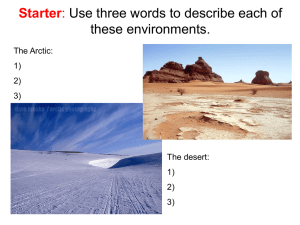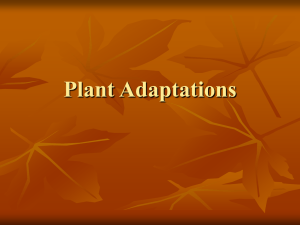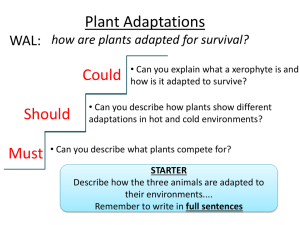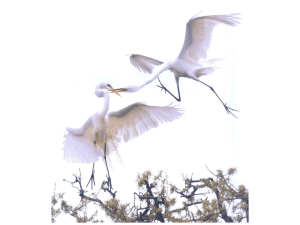Science - Cardiff International School Dhaka
advertisement
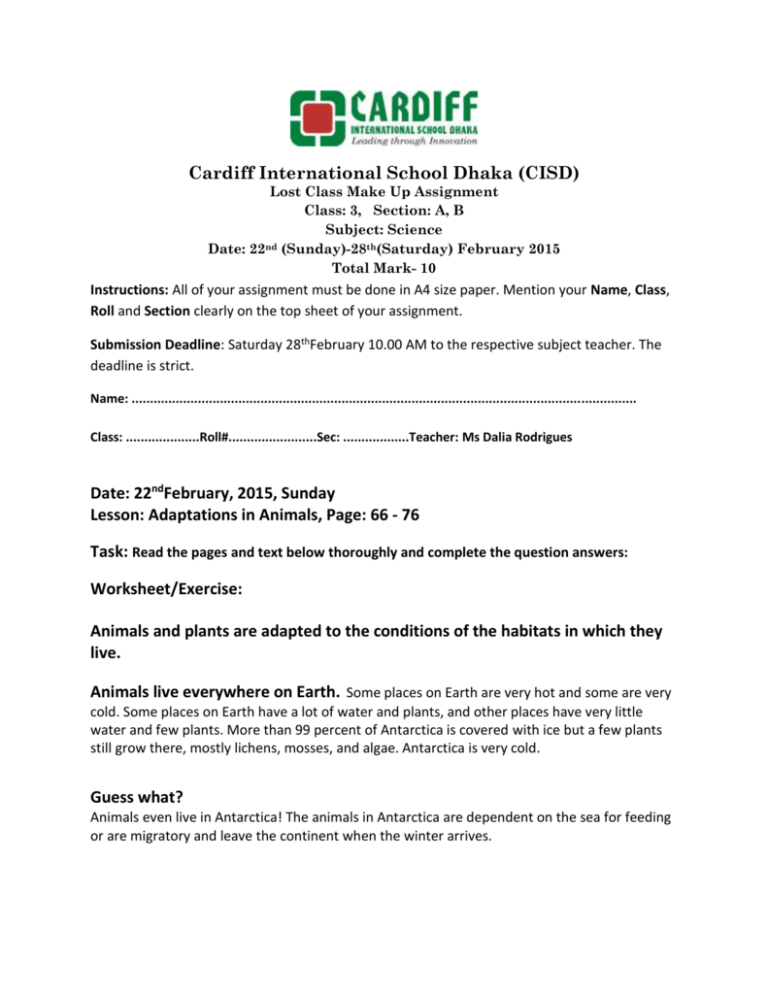
Cardiff International School Dhaka (CISD) Lost Class Make Up Assignment Class: 3, Section: A, B Subject: Science nd Date: 22 (Sunday)-28th(Saturday) February 2015 Total Mark- 10 Instructions: All of your assignment must be done in A4 size paper. Mention your Name, Class, Roll and Section clearly on the top sheet of your assignment. Submission Deadline: Saturday 28thFebruary 10.00 AM to the respective subject teacher. The deadline is strict. Name: ......................................................................................................................................... Class: ....................Roll#........................Sec: ..................Teacher: Ms Dalia Rodrigues Date: 22ndFebruary, 2015, Sunday Lesson: Adaptations in Animals, Page: 66 - 76 Task: Read the pages and text below thoroughly and complete the question answers: Worksheet/Exercise: Animals and plants are adapted to the conditions of the habitats in which they live. Animals live everywhere on Earth. Some places on Earth are very hot and some are very cold. Some places on Earth have a lot of water and plants, and other places have very little water and few plants. More than 99 percent of Antarctica is covered with ice but a few plants still grow there, mostly lichens, mosses, and algae. Antarctica is very cold. Guess what? Animals even live in Antarctica! The animals in Antarctica are dependent on the sea for feeding or are migratory and leave the continent when the winter arrives. Animals can live in many different places in the world because they have special adaptations to the area they live in. What is an adaptation? An adaptation is a way an animal's body helps it survive, or live, in its environment. Camels have learned to adapt (or change) so that they can survive. Animals depend on their physical features to help them obtain food, keep safe, build homes, withstand weather, and attract mates. These physical features are called physical adaptations. They make it possible for the animal to live in a particular place and in a particular way. Each adaptation has been produced by evolution. This means that the adaptations have developed over many generations. Examples of the basic adaptations that help creatures survive: shape of a bird's beak, the number of fingers, colour of the fur, the thickness or thinness of the fur, the shape of the nose or ears Q.1.What is an adaptation? Answer: ……………………………………………………………………………………………………………………………………… ……………………………………………………………………………………………………………………………………………………. ……………………………………………………………………………………………………………………………………………………. ……………………………………………………………………………………………………………………………………………………. Q.2. List five examples of the basic adaptations that help creatures survive. Answer: ……………………………………………………………………………………………………………………………………. …………………………………………………………………………………………………………………………………………………. …………………………………………………………………………………………………………………………………………………. …………………………………………………………………………………………………………………………………………………. ……………………………………………………………………………………………………………………………………………………. ……………………………………………………………………………………………………………………………………………………. ……………………………………………………………………………………………………………………………………………………. Answer Key 1. What is an adaptation? Answer: An adaptation is a way an animal's body helps it survive, or live, in its environment. Camels have learned to adapt (or change) so that they can survive. 2. List five examples of the basic adaptations that help creatures survive. Answer: Examples of the basic adaptations that help creatures survive: • shape of a bird's beak • the number of fingers • colour of the fur • the thickness or thinness of the fur • the shape of the nose or ears Date: 24th February, 2015, Tuesday Topic: Adaptations in Animals Page: 66 - 76 Task: Read the pages and following text carefully and complete the following Worksheets. Worksheet/Exercise: Adaptations for Survival Lesson 1 Vocabulary ⇒ Adaptation: anything that helps an animal live in its environment - can include body coverings and body parts ⇒ Skin: the outer covering of an animal’s body - forms an outer covering for protection of body organs - Keeps the bodies of some animals at the correct temperature - Sensitive to outside temperature change and pain - Can hold water or release it depending on an animal’s needs (amphibians) ⇒ Scales: small, thin plates that are part of the skin covering (some fish and reptiles) - can be smooth, rough, or pointed - added protection for the skin ⇒ Feathers: strong, lightweight outer body covering of birds - parts of the feather lock together (hook lets) so hardly any air can pass through - covered with a layer of body oil (oil waterproofs birds’ feathers, keep a bird’s skin dry, keep its body temperature correct, and help the animal float) ⇒Down: soft, fluffy feathers on baby birds - in older birds, down feathers are found close to the skin - keep the bird’s body at the correct temperature ⇒ Fur: covering of thick, soft hair down feather hook let - thick fur traps air close to the animal’s body - the air is warmed by the animal’s body, keeps the animal’s body at the correct temperature Adaptation-is anything that helps an animal survives in its environment. Outer body coverings-help an animal survive by: 1. protecting its internal organs 2. helps regulate body covering 3. sensitive to temperature changes and pain Fish have scales for outer body coverings Birds have feathers for outer body coverings Bears have fur for outer body coverings Body parts used for protection: 1. Cats have claws for protection. 2. Wolves use their teeth for protection 3. Fish use their scales for protection Body parts use for food getting: 1. A bird uses its bill for getting food 2. A snake uses its curved teeth for food getting 3. A bear uses its claws for getting food 4. A fish uses its mouth for getting food What did you learn? 1. How does its body covering adapt the animal to its environment? Answer: ……………………………………………………………………………………………………………………………………… ……………………………………………………………………………………………………………………………………………………. ……………………………………………………………………………………………………………………………………………………. ……………………………………………………………………………………………………………………………………………………. ……………………………………………………………………………………………………………………………………………………. 2. What body parts does your animal use for food getting? Answer: ……………………………………………………………………………………………………………………………………… ……………………………………………………………………………………………………………………………………………………. ……………………………………………………………………………………………………………………………………………………. ……………………………………………………………………………………………………………………………………………………. Answer Key 1. Outer body coverings-help an animal survive by: a. protecting its internal organs b. helps regulate body covering c. sensitive to temperature changes and pain d. Fish have scales for outer body coverings e. Birds have feathers for outer body coverings f. Bears have fur for outer body coverings 2. Body parts use for food getting: a. A bird uses its bill for getting food b. A snake uses its curved teeth for food getting c. A bear uses its claws for getting food d. A fish uses its mouth for getting food Date: 25th February, 2015, Wednesday Topic: Adaptations in Animals Page: 66 – 76 Task: Quiz question answer Worksheet/Exercise: Vocabulary Adaptation: A specific feature that allows a plant or animal to live in a particular environment. Characteristics: Features that make plants and animals different from each other. Examples are leaf shape, body covering, number of legs, and how animals move. Camouflage: A way of blending into the surroundings so that an organism cannot be seen. Also called “protective coloration.” Environment: The living and nonliving things that surround an organism. Hibernation: When organisms become inactive for a period of time for survival, such as during cold winter months. Migration: When organisms move from one environment to another to find food or a mate. Mimicry: When an organism resembles the appearance, actions, or sounds of another organism. A. Fill in the blanks: 1. The natural surroundings where an animal lives is called its ………………………….. 2. Animals that live on land are called …………………………………….. 3. Birds and ………………………………… can fly in the air. 4. …………………………………. lives on or inside the body of other animals. 5. The quills of a ……………………………….. can cause painful wounds. Answer Key: A. Fill in the blanks: 1. habitat 2.terrestrial 3.bats 4. Parasites 5.porcupine Text Book/Reference Book: I Explore a Science Textbook 4 Help Lines: For any assistance, please contact 1. Coordinator: MsNazmaAkter, Mob. No. +8804478882213 2. Lead Teachers: Ms.Farzana, Mob.No. 01916869056 3. Lead Teachers Ms. Rony, Mob.No. 01741227190 4. ScienceTeachers: Ms. Dalia Rodrigues Mob. No. 01727442114, Mail address: rodrigues_dalia70@yahoo.com 5. Principal Head of School: G.M.NizamUddin, +88-01622181818, gmnu302@yahoo.com
